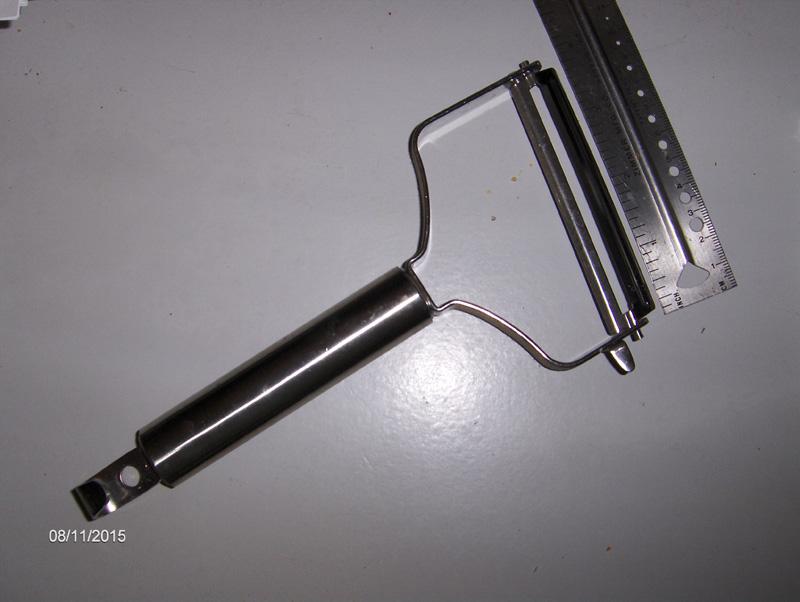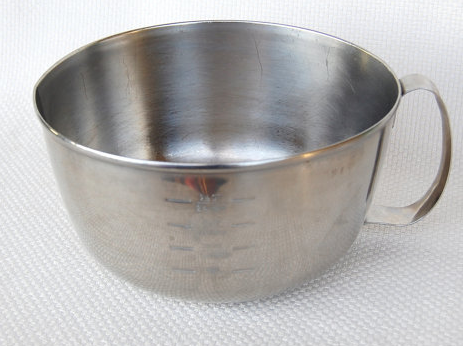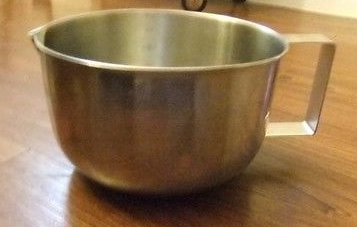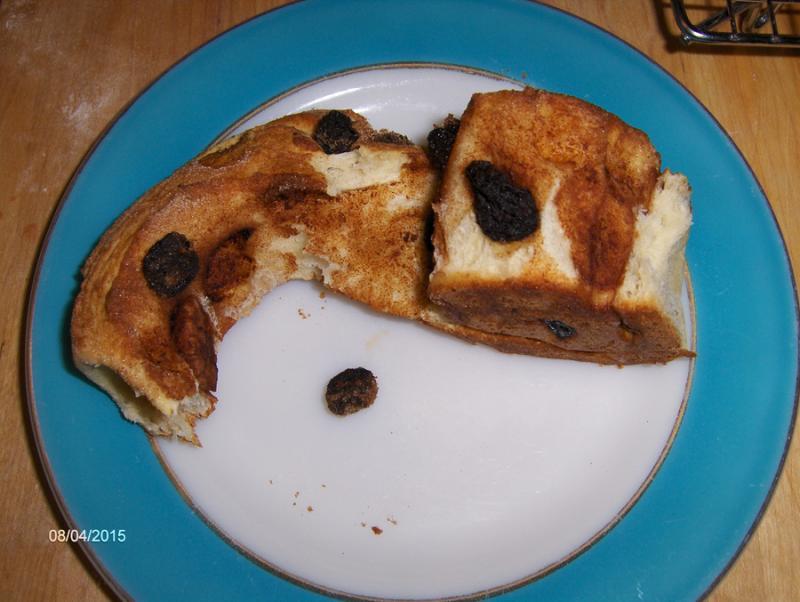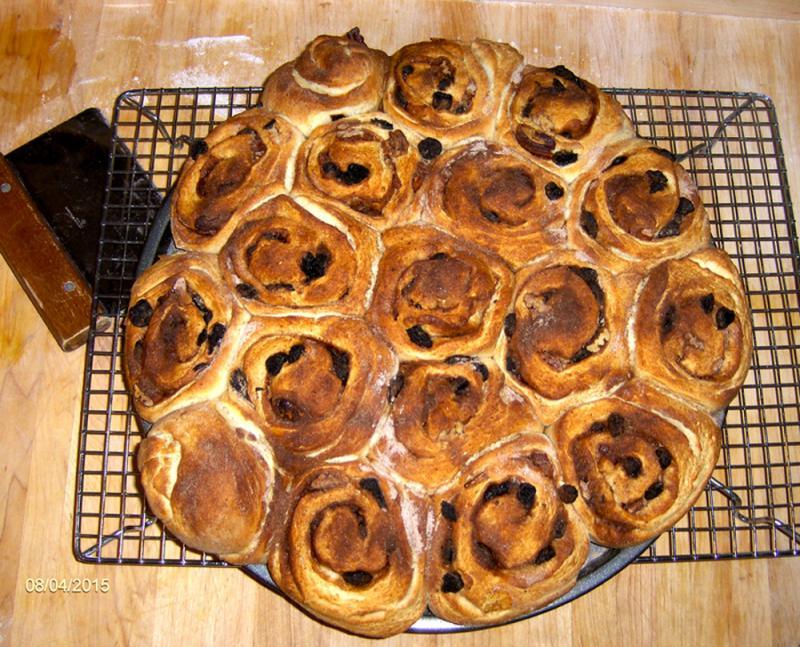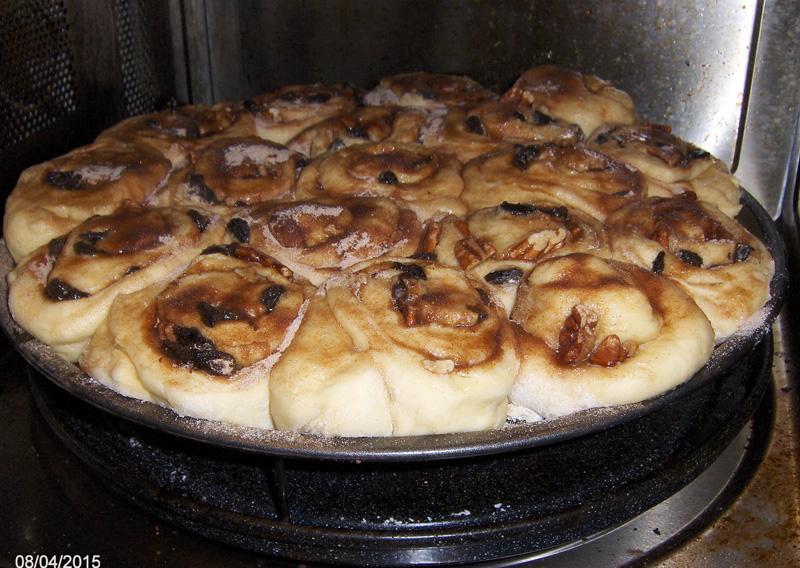-
Posts
11,034 -
Joined
-
Last visited
Content Type
Profiles
Forums
Store
Help Articles
Everything posted by andiesenji
-
My interest was due to the cancellation of all the shows I liked on the food channel. They were airing some ridiculous stuff that held no interest for me whatsoever. A friend from the old SOAR newsgroup (Berkeley: Searchable Online Archive of Recipes - which I got to via BMUG in 1990) sent me the link to eG and I lurked through the holidays late in 2003, was away for most of February and March showing dogs which stopped when I injured my back in April and was laid up. Having been so active for so many years, eG kept me sane during the recovery time from the lumbar fracture and took my mind off the nerve pain. I wasn't one for sharing my problems back then so I don't think anyone knew what I was experiencing.
-
I lurked for a few months (referred by a friend) before joining in April 2004 so I am a bit behind you early birds. The first member to welcome me was Gifted Gourmet - Melissa - and I have missed her posts a great deal.
-
Yes. For the "warty" ones I use a big old butcher knife (one of the cheap Forschners) but for the smooth-skinned varieties I have a giant vegetable peeler - not sure who makes it - that does a terrific job. Also works on melons - I peel watermelons when I am going to pickle the rind. I got it at a restaurant supply store. I have another extra large peeler - a gift from a friend who is always trying to find a gadget I lack. It is called a "dicky or a dinky" I haven't seen it for awhile, probably languishing in a drawer full of junk. When I was younger and stronger I used a "draw knife" for peeling large squash and melons. That was when I had an extensive garden and grew some enormous banana squash - which make a wonderful puree for pies when mixed with pumpkin or even sweet potato.
-
I posted this in this thread 11 years ago. I am posting it again because the season is rapidly approaching and it is best to be prepared. I still cook squash and pumpkin that are destined for puree the same way - seeds and all - and put them through the Foley to remove the seeds and stringy stuff. So much easier and quicker than scraping the stuff out. Posted 13 September 2004 - 06:14 PM Since in some parts of the country autumn is coming on rapidly, I thought I would add this bit of lore. I learned as a child about making pumpkin puree for pies, pumpkin butter and so on - also can be made with the sweeter winter squash varieties, Hubbard, etc., or a combination. Our cook always scrubbed the squash very well and pared off most of the tough, outer skin with a big old knife almost as big as a machete. She would then chop it into chunks and put it in a big pot, seeds and all, cover with salted water and cook until it was very tender, i.e., a piece speared with a fork would fall apart. If everyone was busy and no one was available for frequent stirring, the pot was stuck into the oven and the squash was slow roasted till tender. The resulting pulp was put into a food mill in batches and processed until just the seeds and stringy stuff was still in the mill, that was then dumped out by reversing the motion of the scraper, given a quick rinse and then the next batch was done. It was felt that the seeds, cooking in with the flesh of the squash or pumpkin added something to the quality of the final product and I have found that when I make pumpkin puree this way it does have a richer flavor. Often the seeds split and the meat from inside pops out and is incorporated into the puree. Sometimes the squash or pumpkins do not have a lot of seeds and I simply add some raw pepitas to the mixture - sometimes grinding them first - the addition helps to thicken the puree in addition to the flavor they add.
-
I have peeler/corers too - the hand-cranked type (originally invented by the Shakers in the mid-1800s) which works a treat and I also have an electric "Rotato" still in box, never opened, purchased for my collection of odd gadgets. I saw one demonstrated at Gottschalks dept store several years ago (store now defunct) and thought it might be worth having. Apparently somebody is buying them after all these years, as evidenced here. Amazon sells them.
-
Where I grew up in western Kentucky, it was quite humid most of the year. When the beans were ready for harvest - after the pods had become quite brittle, the vines or bushes were cut, hauled in and were spread out in the hayloft in the big barn, which had cross ventilation and they dried out nicely, safe from the rain and were ready to "thresh" before the haying. The bean thresher was an odd contraption that was at least 20 years old when I was a child in the '40s and it was operated by a "coal-oil" (kerosene) engine that was very temperamental. Naturally all this was extremely fascinating to me and my cousins and we were always underfoot when it was operating. It was interesting to see the dry vines and pods fed in at one end, see the chaff blown out into a pile at one side while the beans went into burlap bags at the far end. The "chaff" was spread over the soil in the fields and tilled in before winter crops were sown.
-

Confession Time: Share Your Culinary "Sins"
andiesenji replied to a topic in Food Traditions & Culture
It is called being a "maverick" in the kitchen. It is YOUR kitchen, your food, fix it the way YOU like it and to hell with anyone who criticizes. -
Price is a little steep. I have a couple of spiralizers - used them a few times but then lost interest except in rare instances. I guess there is only so much you can do with vegetable noodles before they get sort of "meh" at least to me. It is much easier to cook spaghetti squash and I can find a lot of other uses for the types of vegetables that can be spiralized. I love pasta and there is simply no way the veggie noodles taste the same or have the desirable texture - to my personal taste. A friend who has celiac disease told me about the brown rice noodles, no wheat, and I tried a few different shapes, spaghetti, elbows, fusilli, even lasagna noodles. Turned out very nice.
-
I like the site from your link. I have a very nice fairly new poppyseed grinder but I also have a very old one, which I treasure. It was given to me by an elderly neighbor (when I was in my 30s) from Poland because her children were not interested in traditional baking and I had helped her (along with a couple of other women) to make the huge sheet of thin dough for strudel - I can't remember what she called it. Also the smaller sheets for chrusciki and a pastry she rolled and made into a ring - filled with apples and poppyseed I can't recall that name either. She also taught me to make the egg dumplings I still prepare (rarely because they are very fattening) that are plopped into chicken soup or bigos - hunter's stew.
-
Recipe for Poppyseed Cake The original recipe, as written out by Aunt Vera in 1964, was a bit sketchy in that she did not use regular measuring cups - she used coffee or tea cups and I took the time to actually measure the capacity of the ones in her kitchen, while she was demonstrating the cake-making technique. Later I did the weight conversion and even later did the metric conversions. German-style Poppyseed cake – from Aunt Vera Odekirk, my stepfather’s sister. 1 cup butter - 8 ounces or 226 grams. 2 1/2 cups all-purpose flour, 17 1/2 ounces or 500 grams. 1/2 cup poppyseed 2 1/2 ounces or 80 grams 1 cup buttermilk or equivalent – 8 ounces or 226 grams. 2 teaspoons almond extract 4 large eggs, separated 2 cups sugar, 15 ounces or 425 grams 1 teaspoon baking powder 1 teaspoon baking soda (bicarb) 1/2 teaspoon salt – (if using kosher flake salt use 3/4 teaspoon) 1 tablespoon ground cinnamon - (15 to 20 grams, measurement is not critical) Optinal may use a "sweet spices blend" or cardamom PREP: First gather and measure all the ingredients. Grease and flour a standard Bundt pan or 10-inch tube pan. .Preheat oven to 350 degrees F. 176 degrees C. In a dry skillet, over low heat, gently toast the poppyseed for about a minute. Mix the poppyseed into the buttermilk and add the almond extract. Set aside. Measure the flour, baking powder, baking soda and salt into a bowl and blend with a whisk. Set aside Mix 1/4 cup (55 grams) of the sugar with the cinnamon. Set aside. METHOD: Make sure mixer bowl and beater(s) are clean, dry and free of any traces of oil. Place the 4 egg whites in the mixer bowl and beat on high speed until foamy. Continue beating and while mixer is running, add 1/4 cup (55 grams) of the sugar. Beat until whites hold a stiff peak but remain glossy. (DO NOT OVERBEAT!) Transfer whites to another clean bowl. (Unless you have another mixer bowl.) Place the butter and 1 1/2 cups ( 315 grams)of the sugar in the mixer bowl and beat on high until light and fluffy. Add the egg yolks, one at a time, beating until each is completely blended. With the mixer running on low speed, gradually add the buttermilk mixture and mix until well blended. Add 1/4 of the flour mixture and beat on low speed until blended, continue adding the flour mixture in increments until completely blended on medium speed. Remove the bowl from the mixer. With a wide, flat spoon or rubber spatula, fold the egg whites gently into the batter until well blended. Ladle or pour half the batter into the prepared pan. Scatter half of the sugar/cinnamon mixture onto the batter. Pour the remainder of the batter into the pan. Add the rest of the sugar cinnamon mixture, sprinkling it evenly over the batter. Insert an icing spatula or thin-bladed butter knife into the center of the batter and while turning the pan, draw it in an S-shaped pattern completely around the tube. Place the cake on center rack in preheated oven and bake for 70 minutes. Test at 60 minutes. If the cake springs back when lightly touched, it should be done, if a depression remains, continue baking for the additional ten minutes. Remove from oven and cool in the pan for fifteen minutes. Invert onto cake plate. If the cake does not immediately come free, place a towel moistened in ice water over the pan and shake the pan gently. Traditionally, this cake was never iced. It was served plain but with fruit preserves and thick cream on the side to be added if desired. It was also served with whipped sweet butter and spiced apple compote.
-
I'm posting this because it does have a recipe but also the story is hilarious. Hamentachen Filling - Poppy Seed Please read it through to the end. The thing is that I recommend Kosher recipes for things like this because there is no use of corn syrup - honey is the usual sweetener, and I happen to like the flavor of the versions made by the numerous Jewish cooks I have known over the many decades I have been enjoying these foods. I have a recipe for poppy seed cake, I will have to search for it.
-
In the south, these are known as "shellie" beans - the most popular variety are like the ones you pictured - like in this link. And they are cooked differently than dried beans, no need for pre-soaking. They are lovely when braised, which is my preferred way of cooking them. I came across this recipe a couple of years ago (while searching for something else) and bookmarked it. It is almost identical to my method except that I also add about half a cup of chopped celery. While the pods have dried, the beans are not yet classified as dried so are perishable and subject to mold unless you dry them yourself in a dehydrator or very low oven - if you live in a humid climate - I just put them in a big wire colander and let them set on the counter for a week or so - as the usual humidity here in the summer is less than 20. When I was a child in Kentucky, we called these "bird egg" beans because they were speckled like bird eggs. Incidentally we also harvested the big limas - known as "butter beans" at this stage because we liked the flavor and texture much better than "green" limas. This was one of the "chores" meted out to me and my cousins because at our size, we could pick the pods without bending over.
-

Your Daily Sweets: What Are You Making and Baking? (2015)
andiesenji replied to a topic in Pastry & Baking
I have a friend who makes the Parrozzo cake for Christmas. It requires a lot of eggs - and she uses cake flour plus just a small amount of semolina and I know she grinds blanched almonds to a "mealy" texture because they don't like the way it turns out with almond flour. The slice I had was not super moist but also wasn't crumbly or dry. She baked it in a large Pyrex bowl and left it in the bowl until it was completely cool. -
The one I posted a link to - here - is virtually identical in shape, size and contour to the older ones I have from West Bend and Farberware - only the shape of the hadle varies. West Bend Farberware Korean
-

Your Daily Sweets: What Are You Making and Baking? (2015)
andiesenji replied to a topic in Pastry & Baking
Nothing so fancy for me. Just some homely cinnamon rolls (with raisins and pecans). I used a bread machine recipe for Hawaiian Sweet bread with some almond flour substituted for some of the regular flour. I let the bread machine do all the mixing, kneading, rising, until it was time to pull it, stretch and roll it and "fill" with cinnamon, sugar, pecans and some homemade raisins from jumbo seedless red flame grapes. These are much "sturdier" than regular sweet roll dough and freeze beautifully. And they are medium-large. That is a 15 inch pizza pan on which they are baked. Also no egg wash. I brushed the tops with a lot of melted butter and then sprinkled with more of the cinnamon/sugar mix. -
Addendum to my previous post. I had another chat with Joel - yesterday we spoke for more than two hours - have not been in touch for fifteen years so a lot of catching up was needed so we chatted today for another hour. He noted that the mixing bowls came in two sizes, the 3-quart and a smaller one that was about half the size. The reason the aluminum ones were discontinued (along with several other product lines in 1980) was that the handles "popped off" and the problem was the welding machines that did the "spot" welds. Not only did the handles separate, they took part of the bowl with them so that there were 2 HOLES in the sides of the bowls, rendering them useless. Many were returned to the factory directly from consumers or from retailers that got them back from customers. In any event it was a failed line. He believes they were only distributed in a limited area (midwest) at dime stores and drug store that carried general merchandise, while the stainless steel line was distributed nation wide at department stores and the then big box stores like Gemco. Both were sold in a set with the two sizes of mixing bowls, a set of 4 measuring cups and a set of measuring spoons and a utility scoop. His wife used to have the full set of the SS but she is not sure she can lay hands on it but if so, he will take some photos and email them to me. West Bend employees got to take "seconds" that didn't make it through the inspection process for "pennies" so most were able to furnish their kitchens for a tiny fraction of the wholesale price - not to mention the retail. A lot of the West Bend stuff that I have been selling on ebay came to me during the '60s and '70s from Joel and early on from my sister, who worked for West Bend during the early '60s, and one of Joel's sisters who also worked as a sentographer in the design section until the late '70s.
-
I got in touch with my "cousin" (my stepfather's nephew-and were in the same class in high school) who worked for West Bend co from 1961 to 2006 (four years after it was acquired by Regal Ware in 2002). He retired after 45 years at the same plant - starting on the polishing machines and ended as a master machinist and floor manager. I emailed him a picture of the bowl and he wrote that the 1970s bowls (there was also a smaller one - he thinks it was 1 1/2 quart) was made in both stainless steel and polished aluminum - the latter a cheaper version of the SS bowls. The aluminum was not a popular item and was discontinued - the handles had a tendency to pop off. As he recalls they were only in production for a year. The earliest ones had measurements in cups and quarts only, after 1978 they added metric measurements on the opposite side. The line was discontinued in 1980 as it was not profitable - the aluminum division was expanding the anodized stuff and dropping much of the plain. If it is stainless steel it will have that designation on the bottom. They did not "mix" aluminum with stainless steel in the line of kitchen items such as canisters, cake carriers, trays, either bare or anodized or "service items" like this bowl or the measuring cups that were combined with it for sales. (The measuring cups had flat handles so they could nest). It was either one or the other. When new the polished aluminum looked like stainless steel but with use the shiny surface rapidly wore off. Some of the cookware had an aluminum "core" to facilitate heat transfer. Now they call it "tri-ply" And it is still all MADE IN WEST BEND and KEWASKUM in Wisconsin. RegalWare, Lifetime, Masterclad, Royal Queen and Saladmaster.
-
I have no need to buy any this year. I saved the seeds from the big batch of apricots from my tree and have dried them so they are ready to crack so I can save the seeds. This particular variety has the sweeter kernels but I limit how much I use because too much can make one quite ill. The Middle eastern store here in town carries apricot kernels sourced from Lebanon. They don't always have them but when they do the price is much better than on Amazon. If there is a store near you, it might be useful to check.
-
I used to order them from SunFoods but now Amazon carries them - I buy these, which are sourced from California. Some are from China - I don't buy foods like this sourced from China.
-
I've got a few of these bowls - West Bend, Farberware and two much newer ones like this. Purchased the latter at the kitchen "outlet" store back when I was still doing some catering - used for different varieties of pancake batter for pancake breakfasts. Nice because a hand-held electric mixer "fits" in the bowl perfectly without banging the lower sides - as happens with the bowl that have smaller bases and taper more. The West Bend are stainless steel - with one exception. I have relatives in Wis who worked for West Bend for years and I got a lot of my West Bend stuff via them, including some items that were never in actual production. This includes one of these bowls that is aluminum and is anodized, has an exterior finish that is "burnt orange" matches the canisters from the 1970s.
-
I could never consume margarine - way back in the '50s, when I first tasted it, I thought it had kerosene in it because that is how it tasted to me. I once nearly got thrown out of a restaurant because the dish of "butter pats" that was on the table was clearly margarine, even though in the menu only BUTTER was mentioned with pancakes and waffles. The server insisted it was butter but I knew it was not and could plainly taste the chemical flavor. I refused to eat the waffle that also had a pat of the stuff on it. Finally the manager came to the table and asked me about my complaint. He took the server aside and shortly she took my plate away and the little bowl of margarine, came back a few minutes later with another waffle and a small cup of whipped butter and it was actually butter.
-
I've got this "talent" in fact, many years ago I did a "party trick" because I could tell what type of fat was in pie pastry (or some other baked goods) in blind tastings. The only time I was stumped was when a strong spice was included in the mix - cinnamon and cardamom were the main culprits. But plain biscuits, rolls and any "short" pastry like pie dough or similar types, were a cinch. I could tell the difference between lard, vegetable shortening, butter and margarine and even some combinations. People could not figure out how I did it but to me the tastes were distinctive and I couldn't understand why other people could not taste the difference. Of course that was when I was quite young and there was none of this "modern" research.
-
There are several dump cakes that include cherry pie filling and dry cake mix. some use crushed pineapple, some don't. There is a vast collection of dump cake recipes on line. Allrecipes And there are the various "types" with different fruits, with pumpkin, with a can of soda, - one a "German chocolate/root beer dump cake" etc. There are several cookbooks that feature dump cakes. On Amazon.
-
I'm surprised I did not see this thread when it first appeared. I have been buying Peppadews from iGourmet since they began carrying them in 2008. (Still have the copy of my order of May 8, 2008, cheesses, pickled hungarian goathorn peppers, peppadew peppers, mostarda di Fichi, Grandma Jones' Pepper Jam... I love them stuffed with cheese - and run under the broiler for about 15 seconds (works on a raclette too). Also in sandwiches, extremely tasty with game meats, hearty cheeses, artisan breads with some "character" and chopped and mixed into pasta salads. Or chopped and sprinkled over the top of pasta in cream sauces - no meat. And they are wonderful when chopped or sliced and added to FRUIT salads. I also add them to Waldorf salad - and my version with chicken. I did not care for the Trader Joe's either. The first time I tried them was from the deli counter at Bristol Farms market. "Deli counter" is sort of a misnomer because any relation to a regular deli is only marginal. Bristol Farms is decidely upscale and their "ready to eat" food presentation and variety is stupendous. I remember having one of the peppers to taste and was so enthusiastic I bought a pound, which was a lot of peppers as they are not heavy. I think I finished the carton within a few days and went back for more. They had to be used up quickly because they don't keep when not in the pickling liquid. So I was thrilled to find the jarred ones online.
-
I have mixed lots of cake batter in my AEG with great results. Small two-layer cakes as well as quick "breads" banana, pumpkin, etc., but where it really shines is in mixing enough batter for larger cakes - 1/2 sheet pan size and 14 inch rounds. - Can't do that with a regular KA. It will also mix enough batter for a thin sponge cake baked in a full-size sheet pan - has to be thin so it can be easily rolled. Before I got the AEG I would have to mix two batches - which is why I had two 5-qt bowls for my KA - had a copper liner for one (sold it on ebay) to beat egg whites. The capacity in the beater bowl is enough for a full-size angelfood or sponge cake and it does a bang-up job on egg whites and I have used it for Italian meringues many, many times. As I said in another post from a few years ago, it is much easier to pour the hot syrup into the AEG than it is into the KA with the beater running. I love the open top. Here's a photo of cake batter in the AEG using the roller/scraper - NOT having to scrape the sides of the bowl saves a lot of time..



